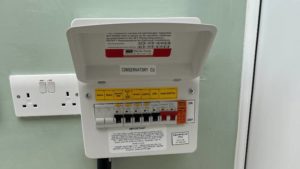Power factor correction capacitors (PFC capacitors) are essential components used to improve the efficiency of an electrical circuit by balancing the inductive and capacitive loads. When there’s a lagging or leading current in a circuit, additional power is required from the supply. A PFC capacitor helps correct this imbalance by providing a leading current, bringing the power factor closer to unity (a power factor of 1). A balanced power factor reduces the overall demand on the supply, resulting in lower electricity consumption.
How Do PFC Capacitors Work?
An electrical circuit is a closed path that allows electricity to flow. When the power factor of this circuit is below optimal, it leads to inefficiencies. Adding a PFC capacitor helps correct the power factor by storing energy in an electric field and balancing out the reactive power in the system. This process reduces the amount of energy drawn from the main supply, ultimately lowering electricity costs and improving system efficiency.
Key Parts of PFC Capacitors
PFC capacitors consist of the following essential parts:
- Capacitors
- Fuses
- Switchgear
- Contactors
- Reactive Power Controller(s)
For fast-changing loads (like welding), contactors are often replaced with thyristor switches for quicker response times. In some cases, in-line reactors are used to reduce harmonic resonance. Where harmonics are a concern, Active Harmonic Filters can be used to both correct the power factor and filter out unwanted frequencies, improving overall power quality.
Where Are PFC Capacitors Installed and What Do They Do?
PFC capacitors are typically installed either locally (for equipment like DOL motors) or at the main distribution board (bulk correction). By supplying reactive power locally, PFC capacitors reduce the overall current drawn from the grid, which decreases electricity wastage and improves cost-efficiency.
How Are PFC Capacitors Installed?
Bulk correction systems are divided into discrete stages that are switched in and out of the circuit using contactors. A reactive power relay monitors the system’s power factor and adjusts the stages to maintain optimal levels. Soft-switching contactors with in-rush attenuation devices are used to prevent surges during switching. Capacitors are installed in parallel to circuits, and the process is quick, requiring minimal maintenance.
Who Should Install PFC Capacitors?
PFC capacitors and other power quality equipment should always be installed and maintained by qualified specialists. While general maintenance teams may overlook specific issues unique to capacitor-switched circuits, a PFC expert can ensure optimal performance and long-term savings.
Installing PFC capacitors leads to improved electrical efficiency, reduced power wastage, and lower electricity bills—making them valuable for industrial and commercial applications.
If you’re interested in learning more about PFC capacitors or need assistance with installation, contact us today for professional guidance and support.

Get in touch with the Martin Cook Electrical Services team today and request your free, no-obligation quotation. Have any questions? We’re here to help with any of your queries.



